Understanding the Social Licence of Carbon Farming in the Australian Rangelands
Abstract
:1. Introduction
2. Background and Aims
2.1. Carbon Farming in Australia
2.2. Social Licence to Operate
2.3. Carbon Farming and the SLO
2.4. Research Questions
- (a)
- Which subfactors are influencing community perceptions of distributional fairness, procedural fairness, confidence in governance, and trust around carbon farming?
- (b)
- Are there any other important influences on the SLO of carbon farming that are not covered by the four factors above?
- (c)
- How do the factors influencing the carbon farming SLO differ from the SLO in mining and other contexts where the SLO has been applied?
3. Case Study Methodology
- “I trust the companies providing carbon farming services in my region to act responsibly” (trust);
- “Generally speaking, the benefits and costs of carbon farming are distributed fairly across the community” (distributional fairness);
- “The carbon farming industry involves fair processes and respects community opinions” (procedural fairness);
- “I have confidence in the legislation and regulations underpinning carbon farming” (confidence in governance).
4. Results
4.1. Survey Findings
4.2. Participant Discussion of SLO Factors
- “[Aggregator] embedded themselves in the local community, they spend money on education and school days and are always at the show. They tick the trendy box, they employ on values and have employed local people. When they come out to conduct vegetation surveys they camp for 7 days or more in 40-degree heat and they make sure they shop locally” (I6, Government)
- “Knowing that they don’t get paid unless we are generating credits helps me sleep at night” (FG1, Landholder with a carbon project)
- “Thought [aggregators] were just Sydneysiders, didn’t trust them, but [they] were great to deal with, they actively built trust with us and are really wearing a big risk” (I2, Landholder with a carbon project)
- “Found out about it at Landcare, had confidence in [early adopter] and he got into it so I gave [aggregator] a call” (I4, Landholder with a carbon project)
- “Would prefer an organisation (such as Landcare) that is non-political and not for profit as this would instil more trust.” (S1, Landholder without a carbon project)
- “We were able to provide jobs for the kids so they didn’t have to keep working in the mines.” (I2, Landholder with a carbon project);
- “It is a boom economically on-farm and off-farm…while it hasn’t been long enough to see evidence of this in the town, not like when you go to cotton towns, it is starting to trickle through” (I8, Government).
- “It has given large income to people on poor country where trees were going to grow regardless.” (S12, Landholder without a carbon project);
- “Generally, more money [is] in the community but not everyone is getting it, [there are] stock agents and graziers that are not eligible” (S19, Landholder with a carbon project);
- “[My wife’s] family are jealous, they are the have nots” (I4, Landholder with a carbon project);
- “Why give some people bucketloads? Why don’t they give a bit to everyone to keep everyone on the land?” (FG2, Landholder without a carbon project).
4.3. Other Factors Affecting Community Acceptance of Carbon Farming
- “We can take risks now with changing our management because we have a guaranteed yearly income” (I3, Landholder with a carbon project);
- “[The income] helped fast-track what we would have done anyway, moved ahead much quicker with putting in infrastructure and rehabilitation practices.” (I2, Landholder with a carbon project);
- “There is a story around the reinvestment… the cash injection lets us expand in a different direction” (FG2, Landholder with a carbon project).
5. Discussion
- Develop trust by capitalising on existing trusted sources to disseminate information, as well as by being careful not to erode these sources of trust through misinformation. The examples of trust-building identified in this study around aggregators and early-adopters could also be drawn on to improve the processes for operationalising carbon farming policies, including spending time in affected communities, sharing some of the risk, and maintaining ongoing involvement in land management and monitoring after deals are made. These strategies align with those from other SLO studies, which emphasise the quality of contact over quantity, keeping promises, and using system disturbances as opportunities to demonstrate shared interests and values [7,8,37];
- Consider existing norms and values, such as the importance of keeping people on the land in active management roles in order to avoid the association between carbon farming and issues of depopulation and absentee landholderships. Consistency with existing norms and values can be enhanced by promoting activities that can be integrated into existing management systems (e.g., carbon farming within a grazing system), rather than being framed as complete replacements or alternatives to current approaches. It is also important to ensure that the processes for determining rules and incentives are flexible enough to account for the changes in norms and values over time, as well as for differences between regions;
- Consider scale when managing transitions to new land uses, such as carbon farming. Local-scale impacts and perceptions are critical for the SLO [32,33], but many of the key processes for carbon farming (and climate mitigation policy, more broadly) are often determined at the national (or even global) scale, such as the development of the eligibility rules and markets for carbon credits. Closing this gap requires participatory approaches to policy development that include landholders, service providers, and government agencies at the state and regional levels in order to enhance confidence in governance, reduce uncertainty, and improve perceptions of fairness;
- Consider the feedbacks that exist between different elements of the SLO, such as the potential for the perceptions of distributional inequity to feed into perceptions of procedural inequity (and vice versa). Such feedbacks can not only accelerate the loss of an SLO, but can also enable the SLO to evolve in an iterative and adaptive manner (e.g., by modifying rules and processes in response to stakeholder views);
- Value co-benefits, such as biodiversity conservation, soil health, and community resilience. While carbon farming has been promoted for its value in mitigating climate change, valuing other co-benefits could allow it to become a viable practice on a greater diversity of properties, and could ensure that the stewardship shown by landholders who may not be eligible for carbon payments is acknowledged;
- Remove information barriers around the abatement potential, market opportunities, and risks. This has the potential to reduce the inequality in the access to incentive schemes, such as the ERF;
- Decrease dependence on a single incentive program, such as the ERF in the case of carbon farming in Australia. This may require the introduction of complementary incentive schemes focusing on different benefits or regions (e.g., through tailored eligibility rules). It also requires that co-investment is fostered so that the government is not seen as the sole driver of land-use change, and so that activities such as carbon farming can be more fully integrated into sustainable agricultural land management. It is also important to recognise nonmonetary incentives, as well as the potential for self-initiated or collaborative actions by landholders that combine conservation and production (e.g., the Landcare program that began in the 1980s, and that has continued despite a reduction in direct financial incentives from the government).
6. Conclusions
Author Contributions
Funding
Institutional Review Board Statement
Informed Consent Statement
Data Availability Statement
Acknowledgments
Conflicts of Interest
References
- Bryan, B.A.; Runting, R.K.; Capon, T.; Perring, M.P.; Cunningham, S.C.; Kragt, M.E.; Nolan, M.; Law, E.A.; Renwick, A.R.; Eber, S.; et al. Designer policy for carbon and biodiversity co-benefits under global change. Nat. Clim. Chang. 2016, 6, 301–305. [Google Scholar] [CrossRef]
- Baumber, A.; Metternicht, G.; Cross, R.; Ruoso, L.-E.; Cowie, A.L.; Waters, C. Promoting co-benefits of carbon farming in Oceania: Applying and adapting approaches and metrics from existing market-based schemes. Ecosyst. Serv. 2019, 39, 100982. [Google Scholar] [CrossRef]
- Jassim, D. Community Perceptions of Carbon Sequestration Projects under the Emissions Reduction Fund in Australia: A Case Study of the Mulga Lands Bioregion, South-West Queensland; The University of Queensland: Brisbane, Australia, 2018. [Google Scholar]
- Baumber, A.P.; Merson, J.; Ampt, P.; Diesendorf, M. The adoption of short-rotation energy cropping as a new land use option in the New South Wales Central West. Rural Soc. 2011, 20, 266–279. [Google Scholar] [CrossRef]
- Cowie, A.L.; Waters, C.M.; Garland, F.; Orgill, S.E.; Baumber, A.; Cross, R.; O’Connell, D.; Metternicht, G. Assessing resilience to underpin implementation of Land Degradation Neutrality: A case study in the rangelands of western New South Wales, Australia. Environ. Sci. Policy 2019, 100, 37–46. [Google Scholar] [CrossRef]
- Zhang, A.; Moffat, K.; Lacey, J.; Wang, J.; González, R.; Uribe, K.; Cui, L.; Dai, Y. Understanding the social licence to operate of mining at the national scale: A comparative study of Australia, China and Chile. J. Clean. Prod. 2015, 108 Pt A, 1063–1072. [Google Scholar] [CrossRef]
- Baumber, A.; Scerri, M.; Schweinsberg, S. A social licence for the sharing economy. Technol. Forecast. Soc. Chang. 2019, 146, 12–23. [Google Scholar] [CrossRef]
- Thomson, I.; Boutilier, R. The social license to operate. In SME Mining Engineering Handbook, 3rd ed.; Englewood, Colo.: Society for Mining, Metallurgy, and Exploration; Darling, P., Ed.; Society for Mining, Metallurgy, Exploration: Englewood, NJ, USA, 2011; pp. 1779–1796. [Google Scholar]
- Edwards, P.; Lacey, J.; Wyatt, S.; Williams, K.J.H. Social licence to operate and forestry—An introduction. Forestry 2016, 89, 473–476. [Google Scholar] [CrossRef]
- Hall, N.L. Can the “Social Licence to Operate” Concept Enhance Engagement and Increase Acceptance of Renewable Energy? A Case Study of Wind Farms in Australia. Soc. Epistemol. 2014, 28, 219–238. [Google Scholar] [CrossRef]
- Roth, G. Retaining the social licence: The Australian cotton industry case study. In Defending the Social Licence of Farming: Issues, Challenges and New Directions for Agriculture; Martin, P., Williams, J., Eds.; CSIRO Publishing: Melbourne, Australia, 2011; pp. 69–83. [Google Scholar]
- O’Brien, J.; Gilligan, G.; Roberts, A.; McCormick, R. Professional standards and the social licence to operate: A panacea for finance or an exercise in symbolism? Law Financ. Mark. Rev. 2015, 9, 283–292. [Google Scholar] [CrossRef]
- Haynes, B. The role of trust in the teaching of history. Educ. Philos. Theory 2018, 50, 174–182. [Google Scholar] [CrossRef]
- Baumber, A.; Schweinsberg, S.; Scerri, M.; Kaya, E.; Sajib, S. Sharing begins at home: A social licence framework for home sharing practices. Ann. Tour. Res. 2021, 91, 103293. [Google Scholar] [CrossRef]
- Griscom, B.W.; Adams, J.; Ellis, P.W.; Houghton, R.A.; Lomax, G.; Miteva, D.A.; Schlesinger, W.H.; Shoch, D.; Siikamäki, J.V.; Smith, P.; et al. Natural climate solutions. Proc. Natl. Acad. Sci. USA 2017, 114, 11645. [Google Scholar] [CrossRef] [Green Version]
- Waters, C.; Cowie, A.; Wang, B.; Simpson, M.; Gray, J.; Simmons, A.; Stephens, S. Abatement Opportunities from the Agricultural Sector in New South Wales: Modelling to Support the Development of the Primary Industries Productivity and Abatement Program; NSW Department of Primary Industries: Sydney, Australia, 2020; p. 170.
- Baumber, A. Social licence and energy cropping: What’s trust got to do with it? Biomass Bioenergy 2018, 108, 25–34. [Google Scholar] [CrossRef] [Green Version]
- Voyer, M.; Gladstone, W.; Goodall, H. Obtaining a social licence for MPAs—Influences on social acceptability. Mar. Policy 2015, 51, 260–266. [Google Scholar] [CrossRef]
- Clean Energy Regulator Sequestration Decision Tree. Available online: http://www.cleanenergyregulator.gov.au/DocumentAssets/Documents/Sequestration%20decision%20tree.pdf (accessed on 4 February 2021).
- Badgery, W.; Murphy, B.; Cowie, A.; Orgill, S.; Rawson, A.; Simmons, A.; Crean, J. Soil carbon market-based instrument pilot—the sequestration of soil organic carbon for the purpose of obtaining carbon credits. Soil Res. 2021, 59, 12–23. [Google Scholar] [CrossRef]
- Evans, M.C. Effective incentives for reforestation: Lessons from Australia’s carbon farming policies. Curr. Opin. Environ. Sustain. 2018, 32, 38–45. [Google Scholar] [CrossRef]
- Baumber, A.; Waters, C.; Cross, R.; Metternicht, G.; Simpson, M. Carbon farming for resilient rangelands: People, paddocks and policy. Rangel. J. 2020, 42, 293–307. [Google Scholar] [CrossRef]
- Bryan, B.A.; Nolan, M.; Harwood, T.D.; Connor, J.D.; Navarro-Garcia, J.; King, D.; Summers, D.M.; Newth, D.; Cai, Y.; Grigg, N.; et al. Supply of carbon sequestration and biodiversity services from Australia’s agricultural land under global change. Glob. Environ. Chang. 2014, 28, 166–181. [Google Scholar] [CrossRef]
- Cunningham, S.C.; Mac Nally, R.; Baker, P.J.; Cavagnaro, T.R.; Beringer, J.; Thomson, J.R.; Thompson, R.M. Balancing the environmental benefits of reforestation in agricultural regions. Perspect. Plant Ecol. Evol. Syst. 2015, 17, 301–317. [Google Scholar] [CrossRef] [Green Version]
- Kragt, M.; Dumbrell, N.; Blackmore, L. Motivations and barriers for Western Australian broad-acre farmers to adopt carbon farming. Environ. Sci. Policy 2017, 73, 115–123. [Google Scholar] [CrossRef] [Green Version]
- Torabi, N.; Mata, L.; Gordon, A.; Garrard, G.; Wescott, W.; Dettmann, P.; Bekessy, S.A. The money or the trees: What drives landholders’ participation in biodiverse carbon plantings? Glob. Ecol. Conserv. 2016, 7, 1–11. [Google Scholar] [CrossRef] [Green Version]
- Franks, D.M.; Davis, R.; Bebbington, A.J.; Ali, S.H.; Kemp, D.; Scurrah, M. Conflict translates environmental and social risk into business costs. Proc. Natl. Acad. Sci. USA 2014, 111, 7576–7581. [Google Scholar] [CrossRef] [PubMed] [Green Version]
- Prno, J.; Slocombe, D. A Systems-Based Conceptual Framework for Assessing the Determinants of a Social License to Operate in the Mining Industry. Environ. Manag. 2014, 53, 672–689. [Google Scholar] [CrossRef] [PubMed]
- Cooney, J. Reflections on the 20th anniversary of the term ‘social licence’. J. Energy Nat. Resour. Law 2017, 35, 197–200. [Google Scholar] [CrossRef]
- Boutilier, R.G. From metaphor to political spin: Understanding criticisms of the social licence. Extr. Ind. Soc. 2021, 8, 100743. [Google Scholar] [CrossRef]
- Dumbrell, N.P.; Adamson, D.; Wheeler, S.A. Is social licence a response to government and market failures? Evidence from the literature. Resour. Policy 2020, 69, 101827. [Google Scholar] [CrossRef]
- Joyce, S.; Thomson, I. Earning a social licence to operate: Social acceptability and resource development in Latin America. Can. Min. Metall. Bull. 2000, 93, 49–53. [Google Scholar]
- Moffat, K.; Lacey, J.; Zhang, A.; Leipold, S. The social licence to operate: A critical review. Forestry 2016, 89, 477–488. [Google Scholar] [CrossRef] [Green Version]
- Hall, N.; Ashworth, P.; Devine-Wright, P. Societal acceptance of wind farms: Analysis of four common themes across Australian case studies. Energy Policy 2013, 58, 200–208. [Google Scholar] [CrossRef]
- Red Meat Advisory Council Australian Beef Sustainability Framework: Governance. Available online: https://www.sustainableaustralianbeef.com.au/governance/ (accessed on 26 October 2021).
- Santiago, A.L.; Demajorovic, J.; Rossetto, D.E.; Luke, H. Understanding the fundamentals of the Social Licence to Operate: Its evolution, current state of development and future avenues for research. Resour. Policy 2021, 70, 101941. [Google Scholar] [CrossRef]
- Dare, M.; Schirmer, J.; Vanclay, F. Community engagement and social licence to operate. Impact Assess. Proj. Apprais. 2014, 32, 188–197. [Google Scholar] [CrossRef]
- Prno, J. An analysis of factors leading to the establishment of a social licence to operate in the mining industry. Resour. Policy 2013, 38, 577–590. [Google Scholar] [CrossRef]
- Andersson, K.P.; Cook, N.J.; Grillos, T.; Lopez, M.C.; Salk, C.F.; Wright, G.D.; Mwangi, E. Experimental evidence on payments for forest commons conservation. Nat. Sustain. 2018, 1, 128–135. [Google Scholar] [CrossRef]
- Pfaff, A.; Rodriguez, L.A.; Shapiro-Garza, E. Collective Local Payments for ecosystem services: New local PES between groups, sanctions, and prior watershed trust in Mexico. Water Resour. Econ. 2019, 28, 100136. [Google Scholar] [CrossRef]
- CMI. Australian Carbon Industry Code of Conduct Version 2.0; Carbon Market Institute: Melbourne, Australia, 2021; p. 31. [Google Scholar]
- Loft, L.; Le, D.N.; Pham, T.T.; Yang, A.L.; Tjajadi, J.S.; Wong, G.Y. Whose Equity Matters? National to Local Equity Perceptions in Vietnam’s Payments for Forest Ecosystem Services Scheme. Ecol. Econ. 2017, 135, 164–175. [Google Scholar] [CrossRef]
- Moser, A.; Korstjens, I. Practical guidance to qualitative research Part 3: Sampling, data collection and analysis. Eur. J. Gen. Pract. 2018, 24, 9–18. [Google Scholar] [CrossRef] [Green Version]
- Dumbrell, N.P.; Kragt, M.E.; Gibson, F.L. What carbon farming activities are farmers likely to adopt? A best–worst scaling survey. Land Use Policy 2016, 54, 9–37. [Google Scholar] [CrossRef] [Green Version]
- Moran-Ordonez, A.; Whitehead, A.; Luck, G.; Cook, G.; Maggini, R.; Fitzsimons, J.; Wintle, B. Analysis of Trade-Offs Between Biodiversity, Carbon Farming and Agricultural Development in Northern Australia Reveals the Benefits of Strategic Planning. Conserv. Lett. 2017, 10, 94–104. [Google Scholar] [CrossRef]
- Robinson, C.; Renwick, A.; May, T.; Gerrard, E.; Foley, R.; Battaglia, M.; Possingham, H.; Griggs, D.; Walker, D. Indigenous benefits and carbon offset schemes: An Australian case study. Environ. Sci. Policy 2016, 56, 129–134. [Google Scholar] [CrossRef]
- Sommerville, M.; Jones, J.P.G.; Rahajaharison, M.; Milner-Gulland, E.J. The role of fairness and benefit distribution in community-based Payment for Environmental Services interventions: A case study from Menabe, Madagascar. Ecol. Econ. 2010, 69, 1262–1271. [Google Scholar] [CrossRef]
- Pascual, U.; Phelps, J.; Garmendia, E.; Brown, K.; Corbera, E.; Martin, A.; Gomez-Baggethun, E.; Muradian, R. Social Equity Matters in Payments for Ecosystem Services. BioScience 2014, 64, 1027–1036. [Google Scholar] [CrossRef] [Green Version]
- Higgins, V.; Dibden, J.; Potter, C.; Moon, K.; Cocklin, C. Payments for Ecosystem Services, neoliberalisation, and the hybrid governance of land management in Australia. J. Rural Stud. 2014, 36, 463–474. [Google Scholar] [CrossRef]
- Gordon, E.; Davila, F.; Riedy, C. Transforming Landscapes and Mindscapes through Regenerative Agriculture. Available online: https://link.springer.com/article/10.1007/s10460-021-10276-0 (accessed on 2 November 2021).
- Ford, R.M.; Williams, K.J.H. How can social acceptability research in Australian forests inform social licence to operate? Forestry 2016, 89, 512–524. [Google Scholar] [CrossRef] [Green Version]
- Berry, E.; Metternicht, G.; Baumber, A. ‘This country just hangs tight’: Perspectives on managing land degradation and climate change in far west NSW. Rangel. J. 2019, 41, 197–210. [Google Scholar] [CrossRef]
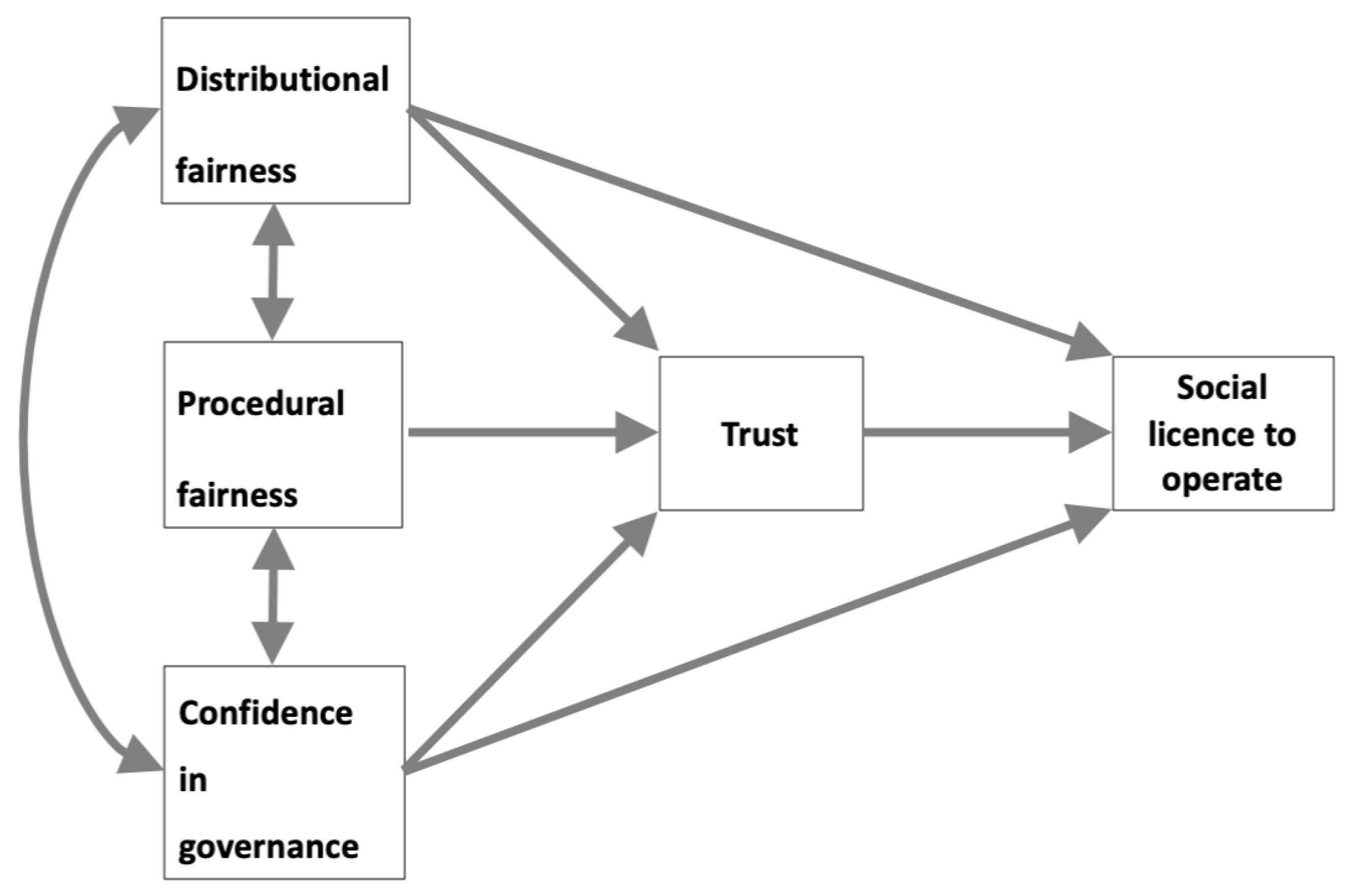
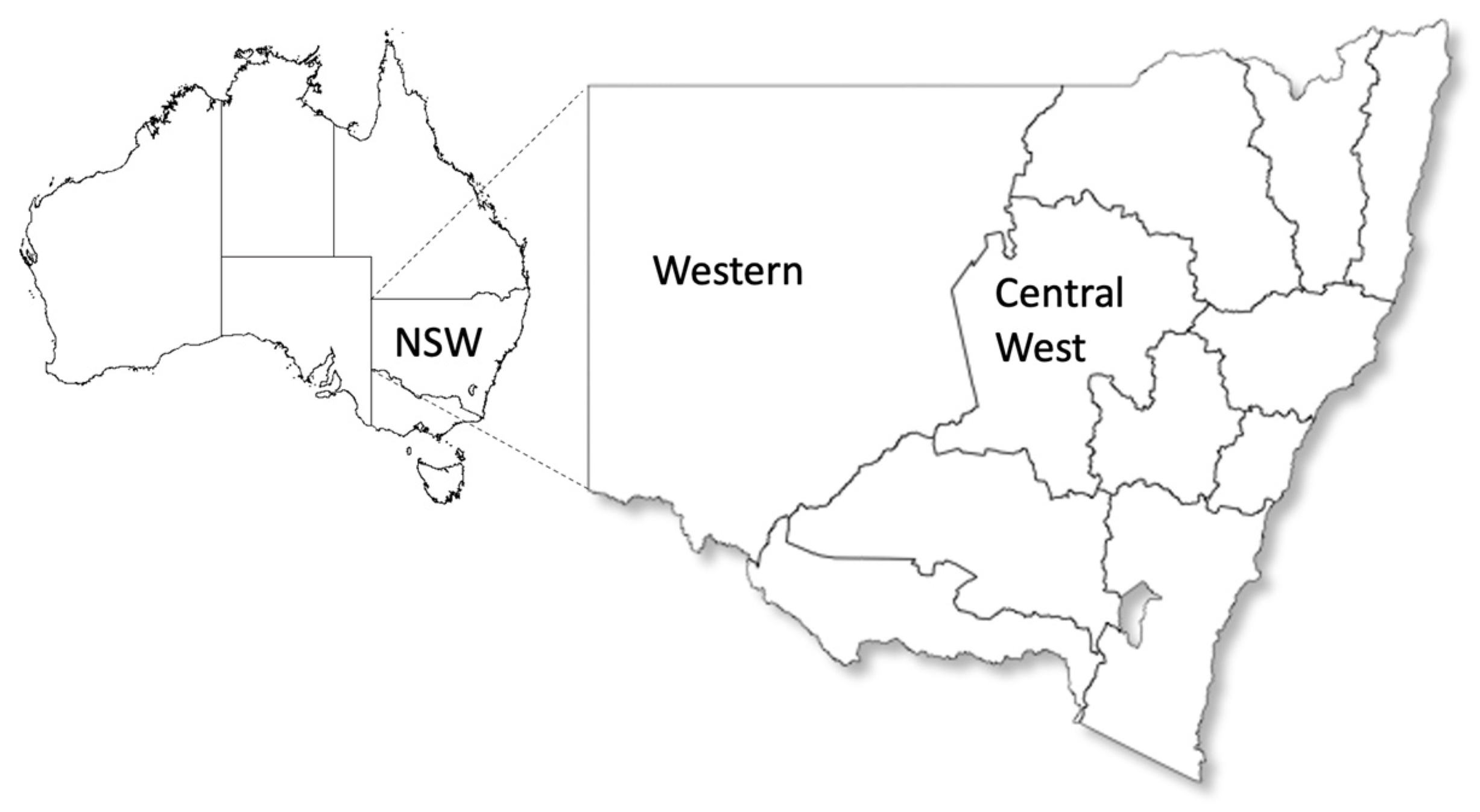

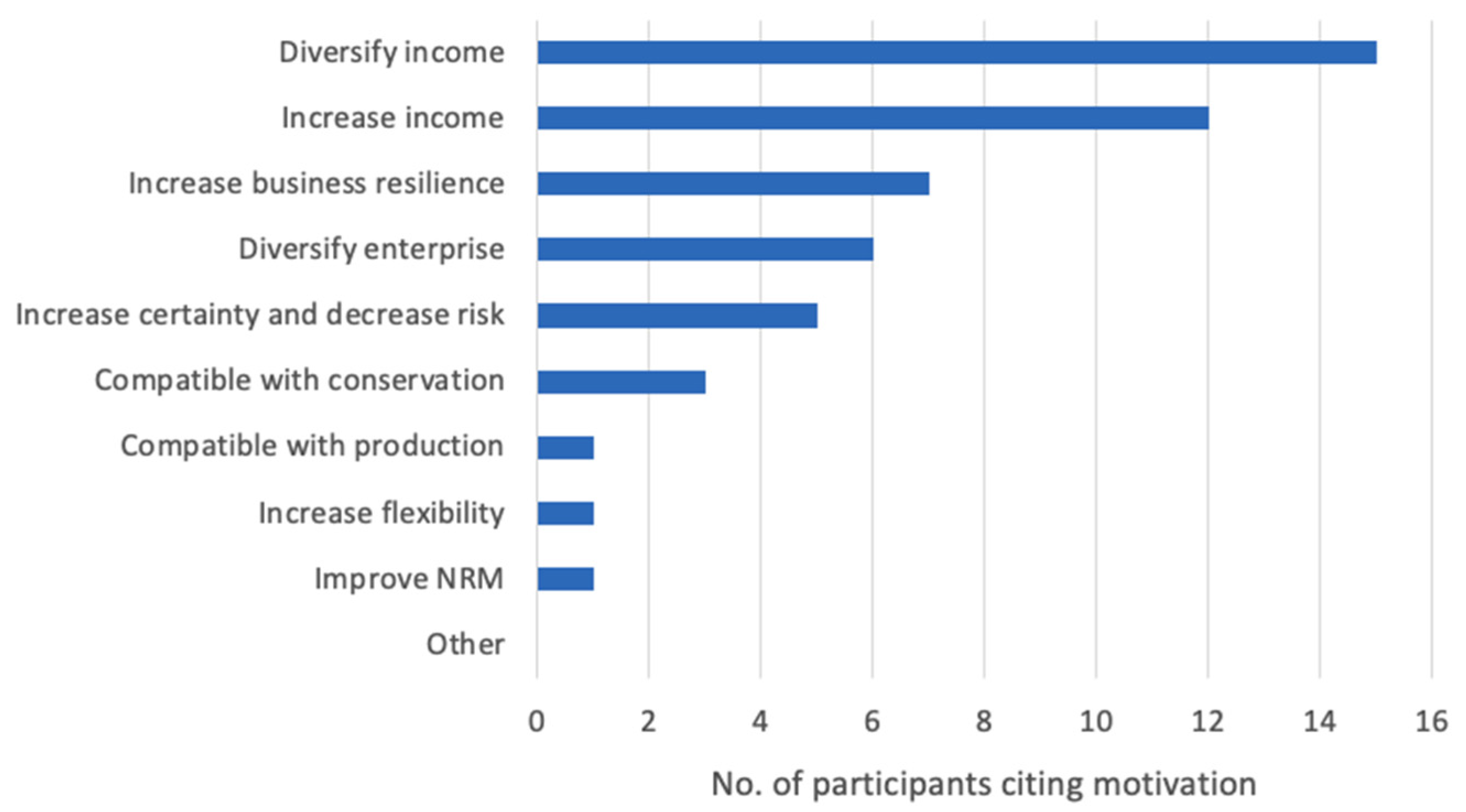
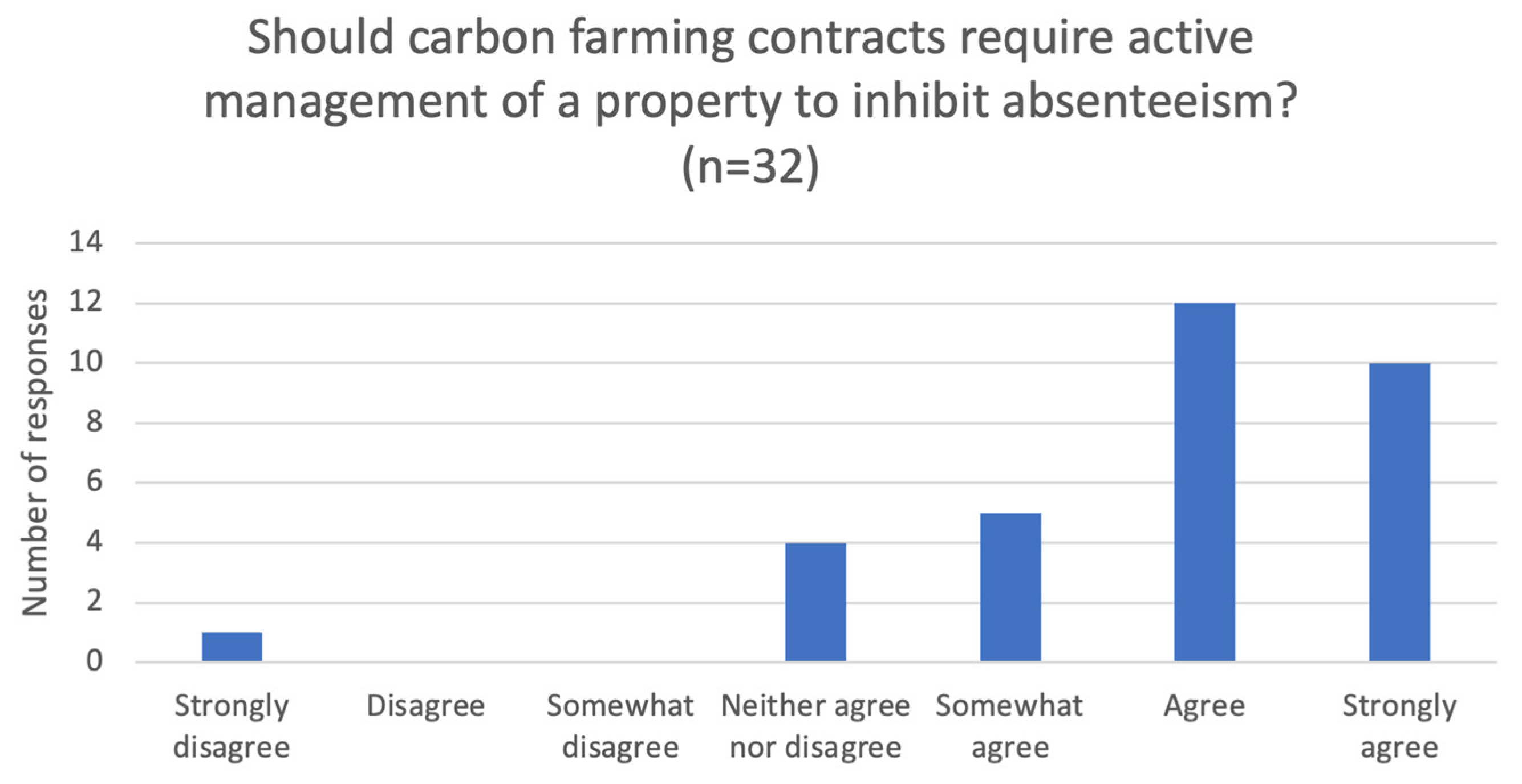
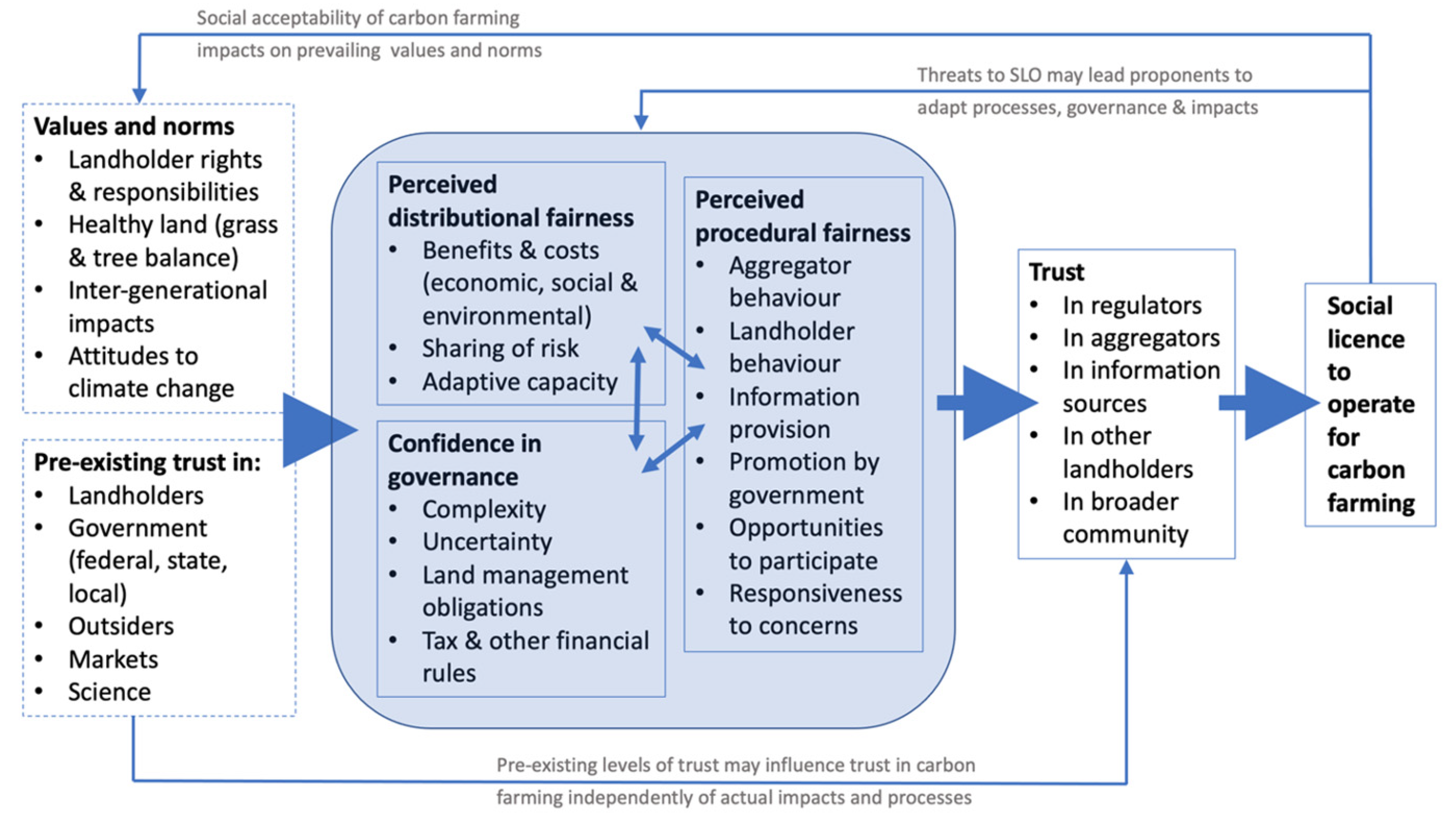
| Complexity of Rules | Lack of Information | Uncertainty |
|---|---|---|
| “Why isn’t it primary production? It was only available to us if we had a PVP (Property Vegetation Plan). We have to maintain firebreaks and help monitor the project and it is only on our property” (I5, Landholder with a carbon project) | “Where do you go to for info? Farmers are not corporate investors and are trusting of those who knock on their door, maybe even gullible. There was no one to go [to], only two LLS staff had any knowledge of carbon farming” (I2, Landholder with a carbon project). | “I question the legitimacy of carbon abatement measured from avoided deforestation and regrowth projects… it creates a very narrow view of a very big complex system” (S23, Government) |
| “Got 3.5 years worth of carbon payments in one year and lost a lot to tax. We would’ve paid it out, but now we’ve put in place things, a different business structure.” (I2, Landholder with a carbon project) | “We had so many landholders asking us very technical questions about carbon farming, many of which remain uncertain to this day. There was a dearth of impartial knowledge in the landscape” (I8, Government) | “Being involved in carbon farming business as a project owner and working in the industry I have found that there is a lot of uncertainty in the future direction of carbon farming (policy)” (S19, Landholder with a carbon project) |
| “Need information on who are you dealing with…need to be shown it is a bonafide system.” (I4, Landholder with a carbon project) | “Uncertainty created by government indecision is most harmful.” (S31, Government) |
| Absenteeism | Need for Active Management | Trees vs. Grass |
|---|---|---|
| “…less people running the landscape” (I8, Landholder without a carbon project) “Carbon farming is driving down the population…” (FG2, Landholder without a carbon project) “…dogs are a major issue on absentee blocks” (I4, Landholder with a carbon project) | “Animal impact is critical in a healthy landscape. Grazing should be permitted with metrics included to ensure it’s having a positive effect on the country e.g., groundcover, SOC.” (S23, Government) “I believe depending on the project being implemented that carbon farming is very complimentary to agricultural production, particularly grazing management whereby production can potentially be increased while simultaneously sequestering carbon in grasslands.” (S6, Landholder without a carbon project) | “Woody weeds have destroyed good land, why now are we wanting to keep it? I’ve been trying to control INS [invasive native scrub] for 20 years…I want to grow grass not scrub” (FG2, Landholder without a carbon project) “I am concerned with the long-term growth of shrubs in the area, as this is/was primarily a grassland landscape.” (S9, Government) |
Publisher’s Note: MDPI stays neutral with regard to jurisdictional claims in published maps and institutional affiliations. |
© 2021 by the authors. Licensee MDPI, Basel, Switzerland. This article is an open access article distributed under the terms and conditions of the Creative Commons Attribution (CC BY) license (https://creativecommons.org/licenses/by/4.0/).
Share and Cite
Baumber, A.; Cross, R.; Waters, C.; Metternicht, G.; Kam, H. Understanding the Social Licence of Carbon Farming in the Australian Rangelands. Sustainability 2022, 14, 174. https://doi.org/10.3390/su14010174
Baumber A, Cross R, Waters C, Metternicht G, Kam H. Understanding the Social Licence of Carbon Farming in the Australian Rangelands. Sustainability. 2022; 14(1):174. https://doi.org/10.3390/su14010174
Chicago/Turabian StyleBaumber, Alex, Rebecca Cross, Cathy Waters, Graciela Metternicht, and Hermann Kam. 2022. "Understanding the Social Licence of Carbon Farming in the Australian Rangelands" Sustainability 14, no. 1: 174. https://doi.org/10.3390/su14010174
APA StyleBaumber, A., Cross, R., Waters, C., Metternicht, G., & Kam, H. (2022). Understanding the Social Licence of Carbon Farming in the Australian Rangelands. Sustainability, 14(1), 174. https://doi.org/10.3390/su14010174







